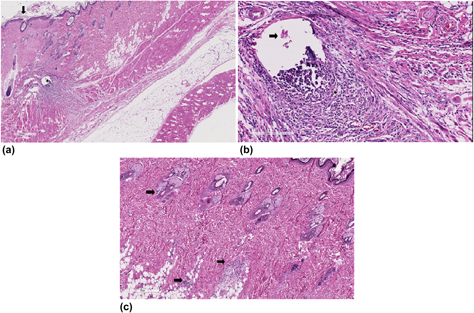Crossref Citations
This article has been cited by the following publications. This list is generated based on data provided by
Crossref.
Isikci Koca, Elif
Bozdag, Gülnihal
Cayli, Gökhan
Kazan, Dilek
and
Cakir Hatir, Pinar
2020.
Thermoresponsive hydrogels based on renewable resources.
Journal of Applied Polymer Science,
Vol. 137,
Issue. 28,
Chakraborty, Indranil
and
Chatterjee, Kaushik
2020.
Polymers and Composites Derived from Castor Oil as Sustainable Materials and Degradable Biomaterials: Current Status and Emerging Trends.
Biomacromolecules,
Vol. 21,
Issue. 12,
p.
4639.
Heiran, Roghayeh
Ghaderian, Abolfazl
Reghunadhan, Arunima
Sedaghati, Fatemeh
Thomas, Sabu
and
Haghighi, Amir hossein
2021.
Glycolysis: an efficient route for recycling of end of life polyurethane foams.
Journal of Polymer Research,
Vol. 28,
Issue. 1,
Andriukonis, Eivydas
Celiesiute-Germaniene, Raimonda
Ramanavicius, Simonas
Viter, Roman
and
Ramanavicius, Arunas
2021.
From Microorganism-Based Amperometric Biosensors towards Microbial Fuel Cells.
Sensors,
Vol. 21,
Issue. 7,
p.
2442.
Farajollah, Reihaneh
Alavi Nikje, Mir Mohammad
Saadat, Ebrahim
and
Abedin Dorkoosh, Farid
2021.
Star-hyperbranched waterborne polyurethane based on D-glucose-poly(ε-caprolactone) core as a biomaterial candidate.
European Polymer Journal,
Vol. 147,
Issue. ,
p.
110318.
de Morais, João Pedro Pereira
Pacheco, Isnayra Kerolaynne Carneiro
Filho, Antonio Luiz Martins Maia
Ferreira, Daniel Cabral Leão
Viana, Felipe José Costa
da Silva Reis, Fernando
de Matos, José Milton Elias
dos Santos Rizzo, Marcia
and
Fialho, Ana Cristina Vasconcelos
2021.
Polyurethane derived from castor oil monoacylglyceride (Ricinus communis) for bone defects reconstruction: characterization and in vivo testing.
Journal of Materials Science: Materials in Medicine,
Vol. 32,
Issue. 4,
Turner, Brendan
Ramesh, Srivatsan
Menegatti, Stefano
and
Daniele, Michael
2022.
Resorbable elastomers for implantable medical devices: highlights and applications.
Polymer International,
Vol. 71,
Issue. 5,
p.
552.
Morales-González, Maria
Díaz, Luis Eduardo
Dominguez-Paz, Carlos
and
Valero, Manuel F.
2022.
Insights into the Design of Polyurethane Dressings Suitable for the Stages of Skin Wound-Healing: A Systematic Review.
Polymers,
Vol. 14,
Issue. 15,
p.
2990.
Haugen, Håvard J.
Schneider, Armin
Schlicht, Henning
Wu, Hongbin
Doundoulakis, Emmanouil
Wilhelm, Dirk
Eblenkamp, Markus
Wintermantel, Erich
and
Feussner, Hubertus
2023.
Long-Term In Vivo Response of a Polyurethane Gastric Implant for Treating Gastro-Oesophageal Reflux Diseases: A Comparison of Different Surface Treatments.
Biomedical Materials & Devices,
Vol. 1,
Issue. 2,
p.
805.
Costa, Tiago
Veiga, Maria I.
Osório, Nuno S.
Neves, Nuno M.
Aguilar, Helena
and
Fraga, Alexandra G.
2023.
Development of polyurethane antimicrobial coatings by composition with phenolic-, ionic- and copper-based agents.
Journal of Materials Research and Technology,
Vol. 24,
Issue. ,
p.
6942.
Uscátegui Maldonado, Yomaira Lisnedy
Díaz Barrera, Luis Eduardo
Valero Valdivieso, Manuel Fernando
and
Coy-Barrera, Ericsson
2023.
Synthesis and characterization of polyurethane films based on castor oil-derived polyols with heparin and low-molecular-weight chitosan for cardiovascular implants.
Journal of Materials Research,
Vol. 38,
Issue. 13,
p.
3349.
Morales-González, Maria
Navas-Gómez, Kelly
Diaz, Luis E.
Gómez-Tejedor, José A.
and
Valero, Manuel F.
2023.
Incorporation of Chitosan in Polyurethanes Based on Modified Castor Oil for Cardiovascular Applications.
Polymers,
Vol. 15,
Issue. 18,
p.
3733.
Gorbunova, Marina
Grunin, Leonid
Morris, Robert H.
and
Imamutdinova, Arina
2023.
Nanocellulose-Based Thermoplastic Polyurethane Biocomposites with Shape Memory Effect.
Journal of Composites Science,
Vol. 7,
Issue. 4,
p.
168.
Miravalle, Edoardo
Bracco, Pierangiola
Brunella, Valentina
Barolo, Claudia
and
Zanetti, Marco
2023.
Improving Sustainability through Covalent Adaptable Networks in the Recycling of Polyurethane Plastics.
Polymers,
Vol. 15,
Issue. 18,
p.
3780.
Morales-González, Maria
Valero, Manuel F.
and
Díaz, Luis E.
2024.
Physicochemical and Mechanical Properties of Non-Isocyanate Polyhydroxyurethanes (NIPHUs) from Epoxidized Soybean Oil: Candidates for Wound Dressing Applications.
Polymers,
Vol. 16,
Issue. 11,
p.
1514.
Wieczorek, Kinga
Bukowski, Przemysław
Stawiński, Krystian
and
Ryłko, Iwona
2024.
Recycling of Polyurethane Foams via Glycolysis: A Review.
Materials,
Vol. 17,
Issue. 18,
p.
4617.
Demirci, Gokhan
Niedźwiedź, Malwina J.
Stefaniak, Nina
Sobolewski, Peter
and
El Fray, Miroslawa
2024.
Injectable and photocurable precursors with their improved adhesive elastomeric films by nature-inspired marine mussels chemistry.
Progress in Organic Coatings,
Vol. 197,
Issue. ,
p.
108818.
Silva, Gabriel Vinicius Alves
Fornazaro, Gabriel
Benati, Gabriel Vinicius Inacio
Companhoni, Mychelle Vianna Pereira
Garcia, Francielle Pelegrin
Halison de Oliveira, Jean
Radovanovic, Eduardo
and
Fávaro, Silvia Luciana
2024.
Toward Sustainable Polyurethane Foams: Effects of Corn Cob Fibers and Silver Nanoparticles on Mechanical Properties and Antimicrobial Activity.
ACS Omega,
Vol. 9,
Issue. 49,
p.
48488.
Betancur, Martha I
Case, Ayden
Ilich, Ekaterina
Mehta, Nalini
Meehan, Sean
Pogrebivsky, Sabrina
Keir, Stephen T
Stevenson, Kevin
Brahma, Barun
Gregory, Simon
Chen, Wei
Ashley, David M
Bellamkonda, Ravi
and
Mokarram, Nassir
2024.
A neural tract-inspired conduit for facile, on-demand biopsy of glioblastoma.
Neuro-Oncology Advances,
Vol. 6,
Issue. 1,
Costa, Tiago
Sampaio-Marques, Belém
Neves, Nuno M.
Aguilar, Helena
and
Fraga, Alexandra G.
2024.
Antimicrobial properties of hindered amine light stabilizers in polymer coating materials and their mechanism of action.
Frontiers in Bioengineering and Biotechnology,
Vol. 12,
Issue. ,



